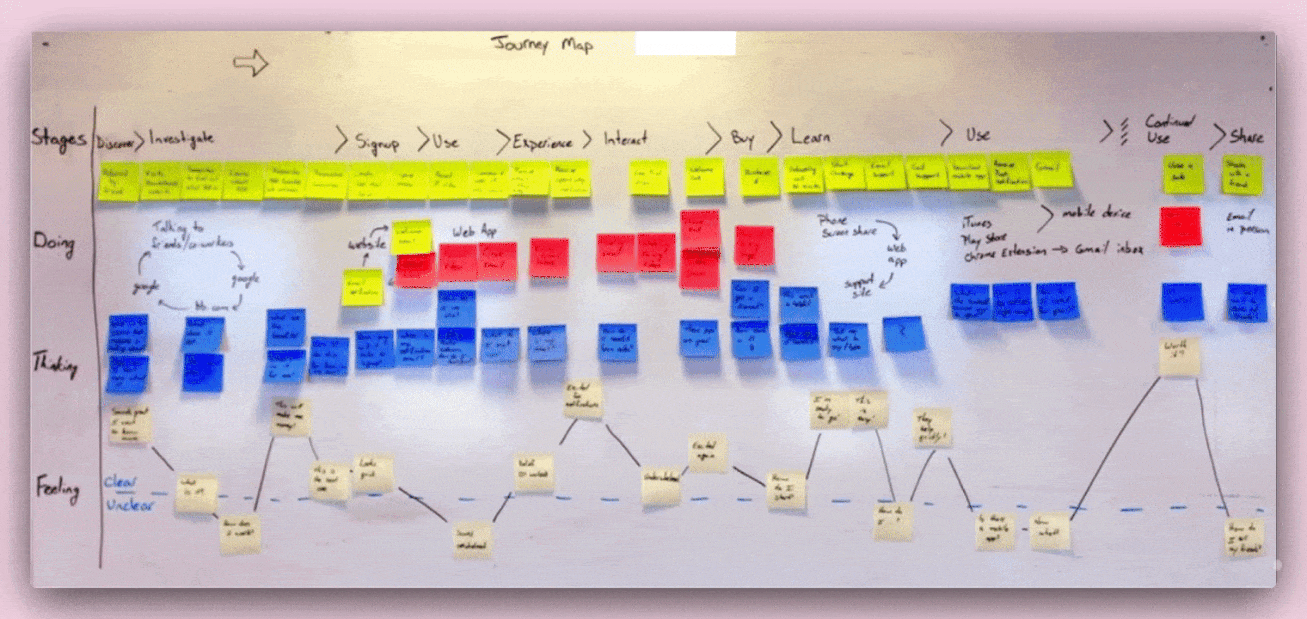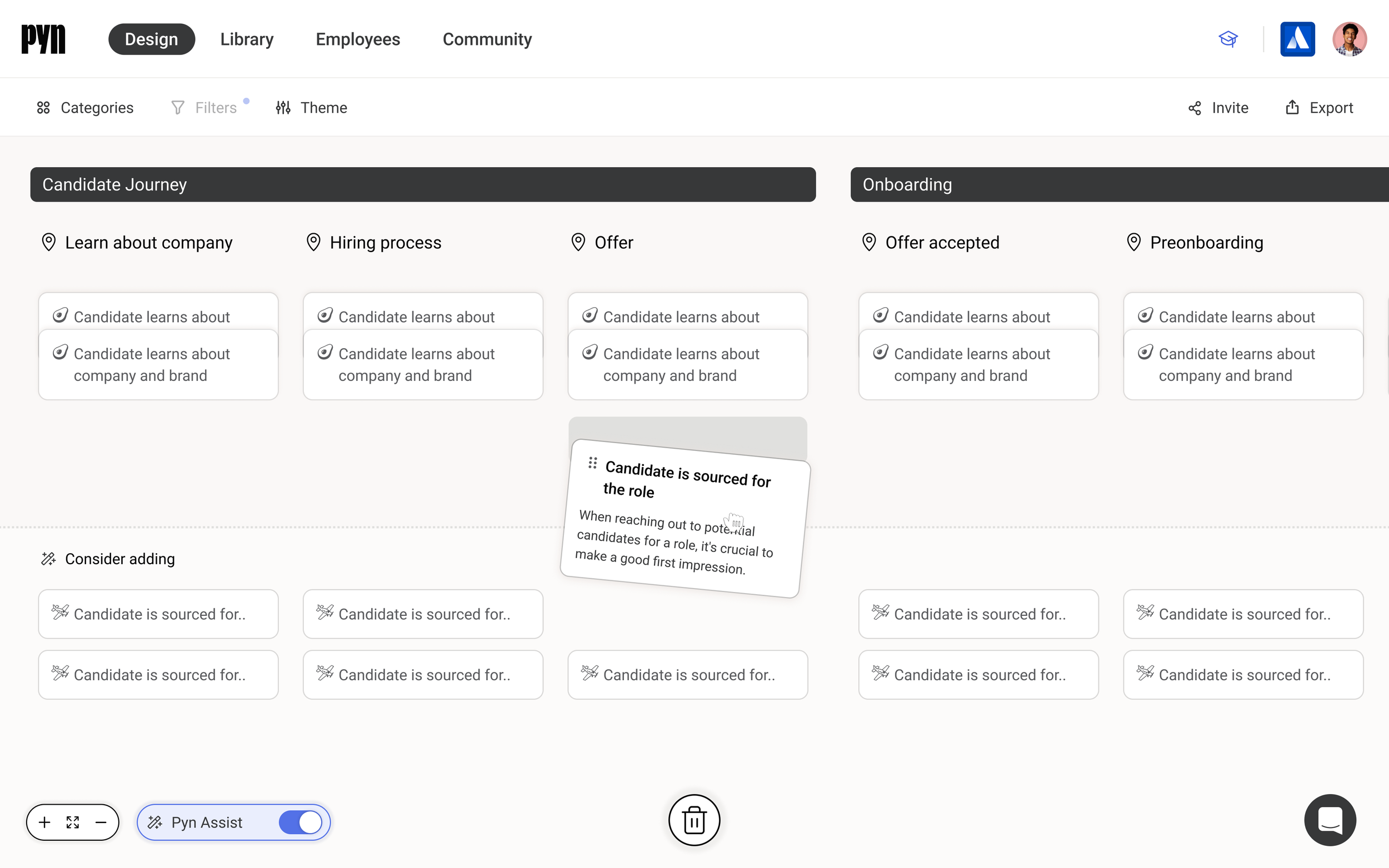The Employee Journey Designer: Would a popular yet undefined concept lead to Product-market Fit?
What is Pyn?
Pyn is an HR tech company with an automation platform designed to deliver timely messages to employees during key moments. The platform is built on the belief that providing information when it’s needed enhances the employee experience. In addition to automation, Pyn offers ready-made HR calendars and expert-crafted message templates written by seasoned HR professionals.
Role
Lead Product Designer
Timeline
10 months | 2023
The Problem
The Business Problem
Post-COVID, many HR-tech companies, including Pyn, struggled as budget cuts targeted "nice-to-have" tools—despite HR practitioners advocating for their value. Without buy-in from decision-makers, these essential tools were often the first to go, challenging Pyn’s product-market fit (yikes!).
With customer churn matching sales, we needed to make a big bet—something bold with enough traction to signal growth to investors. Our co-founders had been noodling on this for a while, and they had an idea they couldn’t stop thinking about.
The Customer Problem
While HR practitioners loved Pyn’s classic product, the CX team consistently reported that customers wanted a way to visualize employee journeys—from pre-onboarding to departure. Pyn provided automations and content for these key moments, but its only visualization was a static PDF.
What’s more, HR leaders wanted a more holistic way to strategize across the HR function and report to the organization, a pain point Pyn wasn’t addressing.
The overarching issue was that they wanted to be able to do more.
The Previous Experience
For HR Strategists
Without a visual employee journey map, HR strategists relied on annual offsite whiteboard sessions or Excel spreadsheets—only to abandon them, despite knowing they could improve the employee experience.
For HR Practitioners
Meanwhile HR practitioners using Pyn could set up automated messaging related to key moments in an employee’s experience but they couldn’t take a holistic, strategic approach and were limited to messaging.
Pyn’s classic automation product
When you're the IC & the Head of
*
When you're the IC & the Head of *
Please excuse the interruption. I’m pressing pause on this case study to paint a picture.
Our team was small, and I was hired as the founding product designer—the sole designer at the startup. The founder, an engineer by trade, had designed the original Pyn, so my role was both on the tools and strategic: I led design as an individual contributor while also serving as a key partner to other team leads. This was a pivotal moment for the company, making it the perfect time for me to revamp our design process and improve how we collaborated cross-functionally on the initiative ahead.
Establishing Process
Human-centered design practices
With years of experience launching initiatives through Design Sprints, I took over staff meetings and Product team meetings to facilitate workshops like “How Might We” and “Pre-Mortems.” This was a full team effort and uniquely supported by the founders.
User Research activities
I integrated Dovetail into our tooling and trained the team in user research. I led generative research efforts and developed a launch strategy that leveraged our small team’s resources—such as gathering insights from prospects and current customers and embedding survey questions into webinars. Our VP of People could absolutely get a job now as a UX researcher, ha!
Elevating PM-Dev-Design process
In a fast-paced startup, it’s easy to prioritize speed over details—but at what cost? I championed design systems, detailed specs, and PRDs, ensuring that all stakeholders provided feedback early. This prevented wasted effort and avoided late-stage surprises about feasibility. It also built rapport, trust, and respect amongst team members as we all felt we had an equal stake and say.
Incorporating our brand
We love our branding, but it can easily be misused. While I’m not the creative director, I often took the initiative to ensure brand consistency. When creating a new product for Pyn, I saw it as an opportunity to get the branding right from the start. Designing alongside the founder, I didn’t hesitate to provide feedback when his work strayed from brand guidelines.
The Solution
As mentioned above, the founders had been thinking about the concept of an employee journey map product for some time. And our engineering founder had the architecture in mind already. He was ready to partner with me to build it.
As an experimental MVP, our goal was to gauge demand—did people want our proposed product, a simple standalone solution, an all-in-one offering, or something else entirely?
Architecture
We built on the founder’s envisioned structure, establishing four hierarchical layers to organize elements of the employee experience.
The map was organized into:
Categories
Candidate Journey, Onboarding…
Moments
Learn about company, Hiring…
Touchpoints
Candidate applies for role…
Actions
Any action associated with the Touchpoint (viewed in the card)
Moving Super Fast
The founder and I built a quick prototype that we could put in front of some folks for feedback.
Garnering Interest
Meanwhile, our amazing marketing team was building a waitlist of over 2,500 companies.
Research
With our prototype in hand, I conducted user research via interviews, surveys, speaking with stakeholders across the business, reviewing sales calls, webinars, and customer feedback. Dovetail was my tool of choice for collating data and it served us well.
Our key finding was that we had a strong foundation and excitement around our concept, but its use case remained unclear, leaving us questioning adoption and unmet user needs.
Next Steps
As the lead, my biggest challenge was persuading the founders to meet baseline expectations before launch. I identified key table-stakes features that could make or break a user’s first impression—potentially leading to abandonment. For example, the ability to add or delete a Moment was essential. Additionally, we needed clear messaging so that both our team and our target audience understood what we were building and why.
Launch
We launched with an MVP, goals in place, metrics to follow, a backlog of fast-follow features ready for the roadmap, user feedback strategy in place, and hives (haha, just kidding!). By and large, the launch went well.
Impact & Takeaways
While a solid launch is a great outcome, the impact wasn’t enough.
Demos for Pyn Classic that came from clickthroughs in the Journey Designer didn’t move the needle for overall business growth
A key metric we set was invitations to the map, and they were minimal
Logins were solid, but people returning to the map were not
The greatest benefit for HR folks was visualization and use of content, not assigning ownership and collaborating holistically with the HR org
What did this mean for the company? Remember this was an experiment.
We could keep pushing forward with this product, building out its features to clarify its concept, achieve table stakes, and better understand user needs and how to address them
We could leave it as is and focus on product-market fit for our core automations product
We could leverage what we learned and build a product that merges our two existing products.*
*they went with the last option























